文章目录
一、8个基本类型及其对应的包装类:
Java中是可以直接处理 基本类型 的,
但Java是一门 面向对象 的语言,
有些时候,需要将其这些基本类型 看作对象来处理 。
Java中有8个基本类型,Java在 Java.lang 包下为其提供了 包装类 ,
当基本类型变成对象后,就可以在其中定义方法,方便开发者操作,
比如:转换成字符串操作等。
| 基本数据类型 | 包装类 |
|---|---|
| byte | Byte |
| short | Short |
| int | Integer |
| long | Long |
| float | Float |
| double | Double |
| char | Character |
| boolean | Boolean |
1. Integer对象的创建、自带方法和
int、String、Integer三者的转换:
1.用构造方法创建Integer对象:
Integer i1 = new Integer(10); //int
Integer i2 =new Integer("10");//String
2.int 转换成Integer对象:
Integer i3 = 10; //自动装箱
Integer i4 =Integer.valueOf(10);//valueOf方法
3.String转换成Integer对象:
Integer i5 = Integer.valueOf("10");//valueOf方法
tips: valueOf() 接受字符串或数字,转换成调用者
4.Integer对象转换成int:
Integer i1 = new Integer(10);
int i2 = i1.intValue();//intValue()方法
int i3 = i1;//自动拆箱
tips: intValue() 以int的方式返回
5.Integer对象转换成String:
Integer i4 = new Integer(10);
String s5 = i4.toString();//toString()方法
6.int转换成String:
String s1 = Integer.toString(10);//toString()方法
String s2 = String.valueOf(10);//valueOf()方法
String s3 = 10 + "";
7.String转换成int:
int i4 = Integer.parseInt("10");
tips: valueOf(10 “10”),接受值,前面写的是谁就转换成谁(String、Integer);
Integer方法中:
intValue() 转换成数字
toString() 转换成字符串
toString(10) 数字转换成字符串
parseInt(“10”) 字符串转换成数字
8.获取int类型的最小值:
int maxint = Integer.MIN_VALUE
9.获取int类型的最大值:
int minint = Integer.MAX_VALUE
10.将int类型的十进制转换成2进制:
String s1 = Integer.toBinaryString(10);
11.将int类型的十进制转换成16进制:
String s2 = Integer.toHexString(10);
12.将int类型的十进制转换成8进制:
String s3 = Integer.toOctalString(10);
2. 其他包装类的构造方法:
1.Boolean:
Boolean b = new Boolean(true);
Boolean b = new Boolean("true");//其余字符串皆为false
2.Byte:
Byte myb = 45;
Byte b = new Byte(myb);
Byte b = new Byte("12");
3.Character:
Character c =new Character("s");
4.Double:
Double d1 =new Double(12.5);
Double d2 =new Double("12.5");
ps:Number是BigDecimal、BigInteger、Byte、Double、Float、Integer、Long、Short的父类。
二、自动装箱拆箱:
1.相关概念:
- 基本类型 之间的转换:
自动转换:小范围到大范围,自动填0补位;
强制转换:大范围到小范围,损失精度;
自动
—————————————>
byte short int long float double
char
<—————————————
(强制)
注意:
① 如果整数没有超出byte、short、char的取值范围,可直接用整数赋值;
byte b1 = 3;
byte b2 = 4;
② byte、short、char做混合运算时,各自都先转换成int再运算;
byte b3 = (byte)(b1 + b2);;
其他例子:
short s1 = 1;//注意①
int s2 = s1 +1;//自动转换成int,之后相加
s1 = (short)(s1 + 1);//int强制转换为short
s1 += 1;//正确,等价于上面
- 引用类型 之间的转换:
向上转型:父类引用子类对象;
向下转型:子类引用父类对象(instanceof);
class Father {}
class Son extends Father {}
Father f = new Father();
Son s = new Son();
Father f1 = s;// 向上造型
if(f1 instanceof Son){ //判断是否可以转换
Son s1 = (Son) f1; // 向下造型
}
Son s2 = f; // 错误
- 基本类型 和 引用类型 之间的转换:
基本类型 —> 引用类型:装箱;
引用类型 —> 基本类型:拆箱;
自动装箱:把基本类型转换为包装类类型
Integer i1 = 10; //10会包装成Integer类的实例对象
自动拆箱:把包装类类型转换为基本类型
int i2 = i1; //i1实例对象会自动转换成int的10
案例:
//map中 key-value 都必须是对象
HashMap<String, Integer> hm = new HashMap<String,Integer>();
hm.put("a", 1); //1,自动装箱
int x = hm.get("a"); //1,自动拆箱
注意:自动装箱 ,或者 valueOf()方法,
对于byte int long short -128到127之间,
对于char 0 到127之间,
存在 享元模式,见下文。
2.享元模式:
Integer n1 = 10;
Integer n2 = 10;
System.out.println(n9==n10);//true
Integer n3 = Integer.valueOf("11");
Integer n4 = Integer.valueOf("11");
System.out.println(n3==n4);//true
//上面用到了享元模式,第二个数也指向第一个数的内存空间
System.out.println("==================");
Integer n5 = 128;
Integer n6 = 128;
System.out.println((n5==n6));//false
Integer n7 = new Integer(11);
Integer n8 = new Integer(11);
System.out.println(n7==n8);//false
//上面没有用到享元模式,是两个不同的内存空间
System.out.println("==================");
3.判断两个Integer类型是否相等:
如果判断两个Integer类型是否相等时,
要使用equals()方法,不要使用"==",
原因和String类一样,Integer类也重写了Object中的equals()方法:
Integer i1 = 128;
Integer i2 = 128;
System.out.println(i1==i2);//false
System.out.println(i1.equals(i2));//true
Integer i3 = new Integer(128);
Integer i4 = new Integer(128);
System.out.println(i3==i4);//false
System.out.println(i3.equals(i4));//true
如果Integer数据是在(-128~127)之间,就会涉及到 常量池(享元模式) 的概念:
Integer i1 = 127;
Integer i2 = 127;
System.out.println(i1==i2); //true
System.out.println(i1.equals(i2));//true
//上面程序不会在堆中创建对象,会直接从整型常量池中拿。
Integer i3 = new Integer(127);
Integer i4 = new Integer(127);
System.out.println(i3==i4);//false
System.out.println(i3.equals(i4));//true
可见,比较Integer的值是否相等时,equals()方法时稳定的。
三、关于数字:
1.Math类:
在java.lang包下,有个Math类,这个类包含用于执行基本数学运算的方法,如四舍五入,开方等等。
public class MathTest {
public static void main(String[] args) {
//圆周率
System.out.println(Math.PI);
//取绝对值
System.out.println(Math.abs(-10));
//ceil天花板,会向上取值,结果是double
System.out.println(Math.ceil(12.3));//13.0
System.out.println(Math.ceil(12.99));//13.0
System.out.println("-----------");
//floor地板,会向下取整,结果是double
System.out.println(Math.floor(12.3)); //12.0
System.out.println(Math.floor(12.99));//12.0
//获取两个值中的最大值
System.out.println(Math.max(20, 30));
//前面的数是底数,后面的数是指数,即2的3次方
System.out.println(Math.pow(2, 3));
//生成0.0到1.0之间的随机小数,包括0.0,不包括1.0
System.out.println(Math.random());
//四舍五入
System.out.println(Math.round(12.3f));//12
System.out.println(Math.round(12.9f));//13
//开平方
System.out.println(Math.sqrt(16));
}
}
2.BigInteger类:
BigInteger类可以让超过Integer范围的数据进行运算,通常在对数字计算比较大的行业中应用的多一些。
import java.math.BigInteger;
public class BigIntegerTest01 {
public static void main(String[] args) {
BigInteger bi1 = new BigInteger("100");
BigInteger bi2 = new BigInteger("2");
System.out.println(bi1.add(bi2)); //+
System.out.println(bi1.subtract(bi2)); //-
System.out.println(bi1.multiply(bi2)); //*
System.out.println(bi1.divide(bi2)); ///(除)
BigInteger[] arr = bi1.divideAndRemainder(bi2); //取商和余数
for (int i = 0; i < arr.length; i++) {
System.out.println(arr[i]);
}
}
}
3.BigDecimal类:
由于在运算的时候,float类型和double很容易丢失精度,
在金融、银行等对数值精度要求非常高的领域里面,
就不能使用float或double了,
为了能精确的表示、计算浮点数,
Java提供了BigDecimal类。
注意:如果对计算的数据要求高精度时,必须使用BigDecimal类
import java.math.BigDecimal;
public class BigDecimalTest01 {
public static void main(String[] args) {
System.out.println(2.0 - 1.1);//0.8999999999999999
//这种方式在开发中不推荐,因为不够精确
BigDecimal bd1 = new BigDecimal(2.0);
BigDecimal bd2 = new BigDecimal(1.1);
System.out.println(bd1.subtract(bd2));
//0.899999999999999911182158029987476766109466552734375
//开发时推荐通过传入字符串的方式
BigDecimal bd3 = new BigDecimal("2.0");
BigDecimal bd4 = new BigDecimal("1.1");
System.out.println(bd3.subtract(bd4));//0.9
//这种方式在开发中也是推荐的
BigDecimal bd5 = BigDecimal.valueOf(2.0);
BigDecimal bd6 = BigDecimal.valueOf(1.1);
System.out.println(bd5.subtract(bd6));//0.9
}
}
四、转载:彻底让你明白 Integer 和 int 的区别:
本文来源:https://blog.youkuaiyun.com/teacher_lee_zzsxt/article/details/79230501
作者:郑州尚学堂李老师
来源:优快云
1.引入:
突然发现自己对Integer i = 10;这种语法不太明白,于是乎有了这篇文章,
那么在讲解 Integer 之前,我们先看下面这段代码:
public static void main(String[] args) {
Integer i = 10;
Integer j = 10;
System.out.println(i == j);
Integer a = 128;
Integer b = 128;
System.out.println(a == b);
int k = 10;
System.out.println(k == i);
int kk = 128;
System.out.println(kk == a);
Integer m = new Integer(10);
Integer n = new Integer(10);
System.out.println(m == n);
}
大家可以先思考一下结果是什么?
答案是:
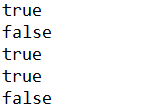
至于为什么是这个结果,下面我们来逐个进行介绍。
2.Integer 类简介:
首先我们大致看一下Integer是什么,Integer 类在JDK1.0的时候就有了,它是一个类,是 int 基本数据类型的封装类。

基本API如下:


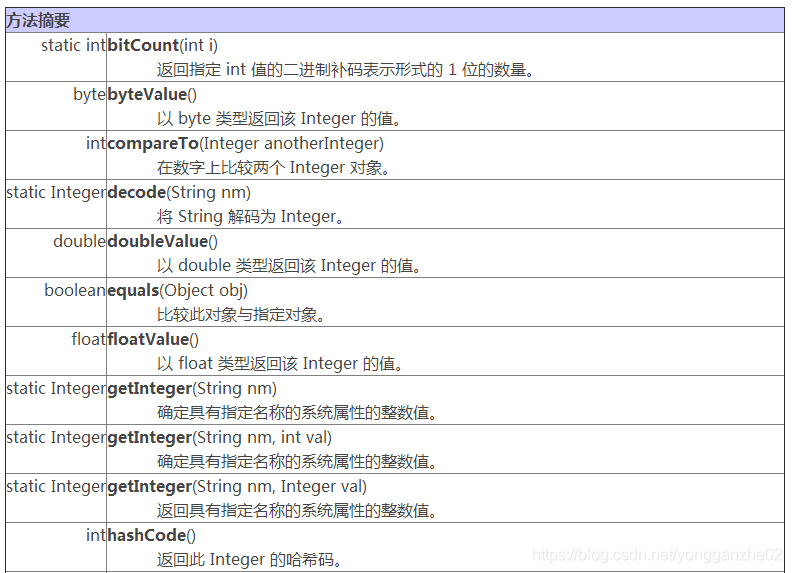
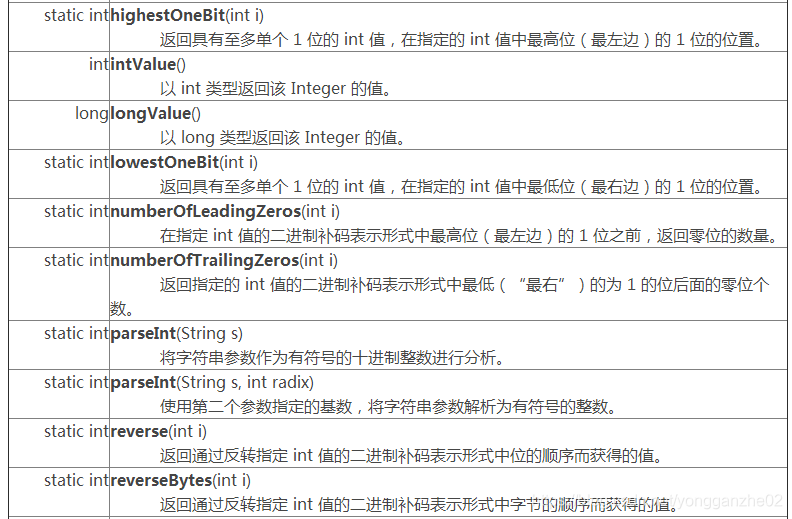
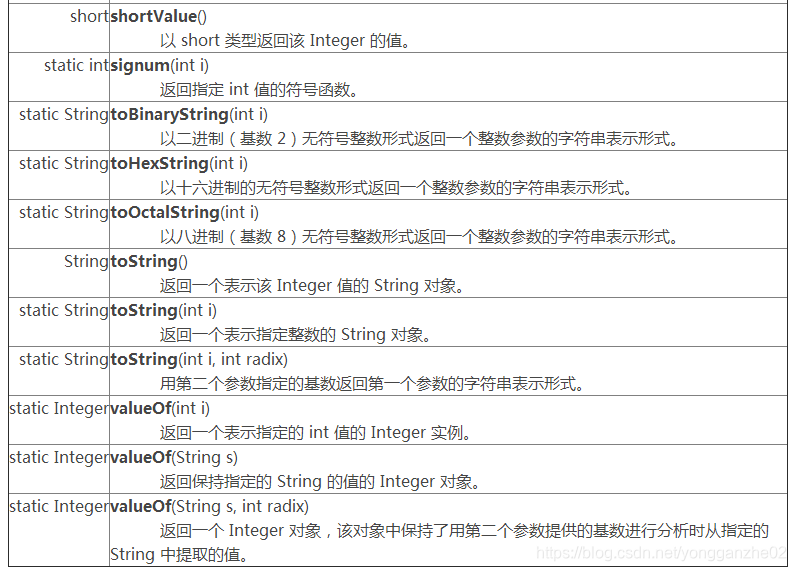
3.Integer 类和 int 的区别:
①、Integer 是 int 包装类,int 是八大基本数据类型之一(byte,char,short,int,long,float,double,boolean)
②、Integer 是类,默认值为null,int是基本数据类型,默认值为0;
③、Integer 表示的是对象,用一个引用指向这个对象,而int是基本数据类型,直接存储数值。
4.Integer 的自动拆箱和装箱:
自动拆箱和自动装箱是 JDK1.5 以后才有的功能,也就是java当中众多的语法糖之一,它的执行是在编译期,会根据代码的语法,在生成class文件的时候,决定是否进行拆箱和装箱动作。
①、自动装箱
一般我们创建一个类的时候是通过new关键字,比如:
Object obj = new Object();
但是对于 Integer 类,我们却可以这样:
Integer a = 128;
为什么可以这样,通过反编译工具,我们可以看到,生成的class文件是:
Integer a = Integer.valueOf(128);
这就是基本数据类型的自动装箱,128是基本数据类型,然后被解析成Integer类。
②、自动拆箱
我们将 Integer 类表示的数据赋值给基本数据类型int,就执行了自动拆箱。
Integer a = new Integer(128);
int m = a;
反编译生成的class文件:
Integer a = new Integer(128);
int m = a.intValue();
简单来讲:自动装箱就是Integer.valueOf(int i);自动拆箱就是 i.intValue();
5.回顾开头的问题:
public static void main(String[] args) {
Integer i = 10;
Integer j = 10;
System.out.println(i == j);
Integer a = 128;
Integer b = 128;
System.out.println(a == b);
int k = 10;
System.out.println(k == i);
int kk = 128;
System.out.println(kk == a);
Integer m = new Integer(10);
Integer n = new Integer(10);
System.out.println(m == n);
}
我们使用反编译工具Jad,得到的代码如下:
public static void main(String args[])
{
Integer i = Integer.valueOf(10);
Integer j = Integer.valueOf(10);
System.out.println(i== j);
Integer a = Integer.valueOf(128);
Integer b = Integer.valueOf(128);
System.out.println(a== b);
int k = 10;
System.out.println(k== i.intValue());
int kk = 128;
System.out.println(kk== a.intValue());
Integer m = new Integer(10);
Integer n = new Integer(10);
System.out.println(m== n);
}
打印结果为:
首先,直接声明Integer i = 10,会自动装箱变为Integer i = Integer.valueOf(10);Integer i 会自动拆箱为 i.intValue()。
①、第一个打印结果为 true
对于 i== j ,我们知道这是两个Integer类,他们比较应该是用equals,这里用==比较的是地址,那么结果肯定为false,但是实际上结果为true,这是为什么?
我们进入到Integer 类的valueOf()方法:

分析源码我们可以知道在 i >= -128 并且 i <= 127 的时候,第一次声明会将 i 的值放入缓存中,
第二次直接取缓存里面的数据,而不是重新创建一个Ingeter 对象。
那么第一个打印结果因为 i = 10 在缓存表示范围内,所以为 true。
②、第二个打印结果为 false
从上面的分析我们知道,128是不在-128到127之间的,所以第一次创建对象的时候没有缓存,
第二次创建了一个新的Integer对象。故打印结果为false
③、第三个打印结果为 true
Integer 的自动拆箱功能,也就是比较两个基本数据类型,结果当然为true
④、第四个打印结果为 true
解释和第三个一样。int和integer(无论new否)比,都为true,因为会把Integer自动拆箱为int再去比较。
⑤、第五个打印结果为 false
因为这个虽然值为10,但是我们都是通过 new 关键字来创建的两个对象,是不存在缓存的概念的。两个用new关键字创建的对象用 == 进行比较,结果当然为 false。
6.测试:
Integer a = 1;
Integer b = 2;
Integer c = 3;
Integer d = 3;
Integer e = 321;
Integer f = 321;
Long g = 3L;
Long h = 2L;
System.out.println(c== d);
System.out.println(e== f);
System.out.println(c== (a + b));
System.out.println(c.equals((a+b)));
System.out.println(g == (a+b));
System.out.println(g.equals(a+b));
System.out.println(g.equals(a+h));
反编译结果:
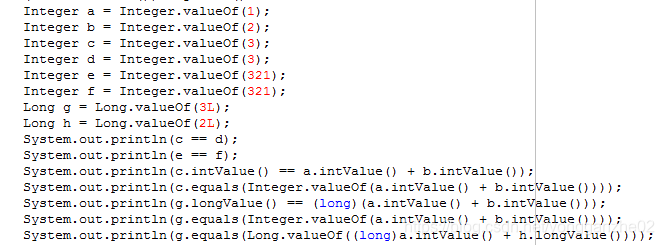
打印结果为:
true
false
true
true
true
false
true
分析:
第一个和第二个结果没什么疑问,Integer类在-128到127的缓存问题;
第三个由于 a+b包含了算术运算,因此会触发自动拆箱过程(会调用intValue方法),
==比较符又将左边的自动拆箱,因此它们比较的是数值是否相等。
第四个对于c.equals(a+b)会先触发自动拆箱过程,再触发自动装箱过程,
也就是说a+b,会先各自调用intValue方法,得到了加法运算后的数值之后,
便调用Integer.valueOf方法,再进行equals比较。
第五个对于 g== (a+b),首先计算 a+b,也是先调用各自的intValue方法,
得到数值之后,由于前面的g是Long类型的,也会自动拆箱为long,
==运算符能将隐含的将小范围的数据类型转换为大范围的数据类型,
也就是int会被转换成long类型,两个long类型的数值进行比较。
第六个对于 g.equals(a+b),同理a+b会先自动拆箱,然后将结果自动装箱,
需要说明的是 equals 运算符不会进行类型转换。所以是Long.equals(Integer),
结果当然是false
第七个对于g.equals(a+h),运算符+会进行类型转换,a+h各自拆箱之后是int+long,
结果是long,然后long进行自动装箱为Long,两个Long进行equals判断。





 本文围绕Java展开,介绍了8个基本类型对应的包装类,包括Integer对象创建、类型转换等。阐述自动装箱拆箱概念、享元模式及判断Integer相等的方法。还提及Math、BigInteger、BigDecimal类的用途,最后深入分析Integer和int的区别及自动拆装箱机制。
本文围绕Java展开,介绍了8个基本类型对应的包装类,包括Integer对象创建、类型转换等。阐述自动装箱拆箱概念、享元模式及判断Integer相等的方法。还提及Math、BigInteger、BigDecimal类的用途,最后深入分析Integer和int的区别及自动拆装箱机制。
















 194
194

 被折叠的 条评论
为什么被折叠?
被折叠的 条评论
为什么被折叠?








